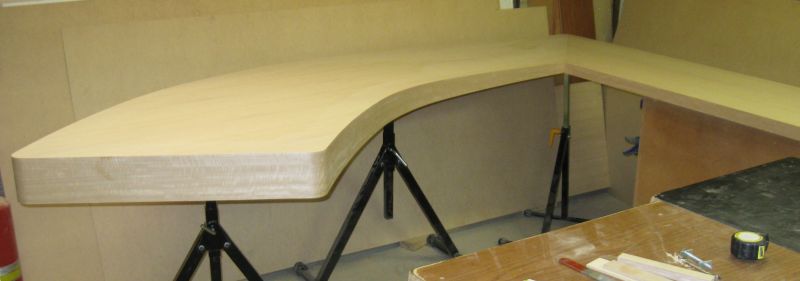Edgebanding With Veneer
Exploring ways to attach matching veneer to the edges of veneered panels. October 3, 2009
Question
I have a project being built from quartered figured cherry veneer and need to order strips of the same veneer for the edgebanding. I do not have an edgebander. How is everyone applying the exotic veneers that need to match? Of course the veneer in not pre-glued and has no backing. Any input would be appreciated.
Forum Responses
(Veneer Forum)
From contributor P:
I use solid wood edging. I have a shaper knife set that cuts corresponding profiles in the edge of the ply and the banding, although a few small biscuits or dowels works equally well. You can just glue and clamp too, but it's nice to have something hold it in place. This is more of a furniture technique and I wouldn't want to do hundreds of feet like that.
From contributor B:
For many years I used contact cement for this purpose. Use fresh (not gummy) solvent-type glue and follow instructions.
From the original questioner:
Thanks for the input. I'm doing a whole house (kitchen, baths, media, etc). The solid wood approach would take forever. I'm worried about the contact adhesive approach because of overspray when I spray the panel. Is there a way to spray just the edgebanding with contact adhesive (or yellow glue) wait for it to dry then just iron it on. Iíve seen one of the cabinet makers at my old work ironing on ebony veneer but I forgot to ask him how he did it. I know there has to be a fast way to do it (well relatively fast without a bander).
From contributor M:
Here's the easiest way I have found to have "custom" veneer edgebanding in a very convenient form. Use a sheet of veneer of the type you want and big enough to cut into all the edge strips you will need. (I usually use 10 mil paper-backed veneer). Use spray-on solvent contact cement and spray the backside of the veneer sheet. Have already ready a piece of 1/8" thick masonite or mdf big enough to stick the veneer sheet onto.
After spraying the contact onto the veneer, flip it over and stick it onto the masonite while the contact cement is still tacky. Do not spray contact onto the masonite. Roll down the veneer onto the masonite just like you were permanently gluing in on. At this point you can either cut the masonite into edging strips, or, as I usually do it, put a final finish onto the veneer sheet and then cut it into strips.
When it comes time to apply the edgebanding to the edges of your panels, simply peel the veneer strips off the masonite. It will come off just like peel-and-stick veneer and be pre-glued and ready to stick onto your contact-cemented edges.
From contributor R:
To the original questioner: all of the recommended methods will take time to do. But the solid wood is the best choice for a job like you are undertaking. You are using expensive wood. I assume this is a high end job. Do you really want to use a thin layer of edge banding? No doubt it will look fine but the solid wood will be there for years after the veneer peels or chips. You will, of course, already have cashed the check but don't you think it wise to offer the best a high paying customer can get?
If you want to really jazz up the job and put a smile on the customer's face, use some type of appropriate solid wood molding. I know that may not be an item off the shelf from your supplier but it could be fabricated with a molding machine or shaper. If you don't own either of these, how about talking around with other shops in your area to outsource from?
From the original questioner:
I need to use the matching veneer so everything looks nice. The client wonít want to see the solid edging either (very contemporary). I appreciate the posts so far but are there any other ways? I have to edge all the doors and cabinet parts as well.
From contributor S:
You can solid edge band the panels then veneer over the entire surface. This eliminates the heavy edge band look. Just use the same solid species as the veneer. The banding only has to 1/8th to 1/4 inch thick. This also makes the edges more durable than veneer tape. This would maintain that consistent face look youíre after.
From the original questioner:
I was hoping to buy the sheets laid up already.
From contributor J:
To the original questioner: try Fastcap's double sided tape. The bond strength is very good.
From contributor C:
Another solution is to order your components laid up to size with a veneer edge applied before the faces.
